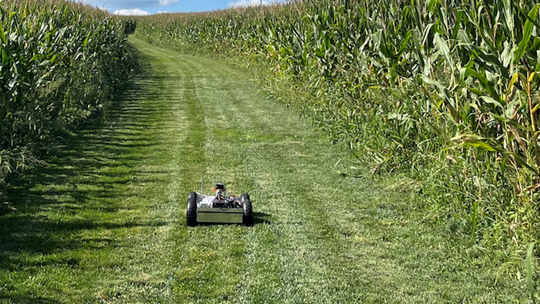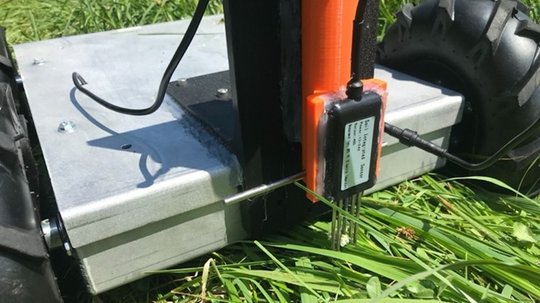
Understanding soil quality is an essential part of farming. After all, maintaining healthy soil is the foundation for productive and sustainable agriculture. Unfortunately, manual soil testing can be an arduous task, especially for those owning large pieces of land.
Seeing an opportunity to provide a more efficient process for farmers, John Crupi, co-founder of Kick Robotics, took initiative. He and his company are working to fill the gap, creating an easier process for farmers to test soil using robotic technology and artificial intelligence (AI).
The idea that formed the company
Crupi has always had a fascination with robotics, especially after finishing his mechanical engineering degree at the University of Maryland, College Park (UMD). “About 10 years ago I got excited because I saw that robotic sensors were really coming of age and, as a result, were becoming more affordable,” said Crupi. “I wanted to try my hand at building a robot as a hobby project with my daughters. We had two dogs at the time, and we thought that it would be a cool idea to see if we could create a robot that automatically senses and picks up pet waste in the yard.”
With a vision in mind, Crupi looked to his alma mater. He asked interns from UMD’s robotics program to help him flesh out concepts. They worked together to create a prototype and overcame a variety of challenges.
“Anything you do with robotics is complicated. In our case, we had the additional challenge of trying to develop a robot that could not only sense pet waste, but also navigate outdoor terrain,” Crupi said. “Then one day we had an epiphany; a lot of the things we were trying to do were, in essence, environmental testing. We were testing things like air quality and methane gas, and with that, we wondered if we could further apply our thinking to other industries.”
Crupi and his team then shifted focus to develop a robot that could help farmers sense nitrogen, phosphorus and potassium levels – elements of fertilizer. Using this technology, farmers could better detect situations like runoffs, which can adversely impact nearby ecosystems.

Building a robot is easier said than done
It was in 2020 that Kick Robotics was officially started, but the team soon realized additional capital was needed to continue research and development.
Thankfully, the Maryland Technology Development Corporation (TEDCO), unveiled a new initiative in 2021, the Agriculture and Rural Rebuild (ARR) Challenge. The program aimed to aid rural and agricultural enterprises in Maryland affected by the persistent pandemic and economic decline. These grants, offering a maximum of $200,000, fostered partnerships among applicants, research institutions and industries, with the goal of fostering enduring technological advancements in the agtech sector and other rural industries.
After going through the diligent application process, Kick Robotics could proudly say they were one of seven ARR Challenge awardees.
Securing funding was just the beginning; to create a working prototype and navigate supply chain issues, Crupi recruited an old friend who owned a metal sign company to help build their team a frame. After some hard work, the team had a working prototype.
Getting feedback and improving
The proposed project had two key phases. In phase 1, Kick Robotics partnered with Antietam Meadows Farm and Dell Farm to better understand how their prototypes would work in and around farms. During this time, the teams sought to answer three questions: (1) could the robot effectively maneuver through fields without getting stuck or bumping into something; (2) could it sense what it was supposed to; and (3) how accurate were the readings?
“Our goal was simple – we wanted to be able to provide farmers with real-time data to save them time and money,” said Crupi.
The partnership provided Crupi and his team with valuable insights, allowing them to tinker and adjust to meet farmers’ needs, a process that allowed them to rethink their business strategy. “We realized we didn’t want to be a robot manufacturing company, but rather a robot solutions company,” said Crupi. “We want this technology to be accessible, especially to rural communities. And we didn’t want farmers to feel like they needed to be robotics experts to tap into this technology, so our plan is to set this up as a subscription service.”
Now, Crupi and the team are working with the Mid-Atlantic Gigabit Innovation Collaboratory (MAGIC) to continue improving. “We are working together to leverage the work we did to create an opensource autonomous robot community, first targeting rural and underserved communities,” said Crupi. “We realized early on that if it takes this much time, effort and dollars to build an industrial strength autonomous robot that can be used for all sorts of use cases. This puts it out of reach for many underserved communities and startups who are trying to build autonomous robot solutions. So, with MAGIC, we’ve begun investigating using the bill-of-materials and specs to jump start an opensource community where anyone can use, enhance, contribute and fast track the robot building part of the solution and focus on the software, solutions and applications.”
While Kick Robotics has made tremendous strides, their work is far from over. Their near-term goal is to expand their services to morea farms while continuing to optimize their robot fleets, allowing them to move in additional environments and detect other parameters, such as mold.
“We are extremely grateful for TEDCO’s support the past few years – the ARR grant was instrumental in helping us develop our prototypes. By the time the grant was done we successfully had an MVP model – we had a working robot,” said Crupi. “We could actually show people this model and how it worked, educate them about what it can do, and get them excited about the technology and potential.”
“Dr. Arti Santhanam and the team at TEDCO were all fantastic to work with. It was a great experience, and I really want to see more of these types of grants and challenges out there because it was a significant boon to our business.”
TEDCO, the Maryland Technology Development Corporation, enhances economic empowerment growth through the fostering of an inclusive entrepreneurial innovation ecosystem. TEDCO identifies, invests in and helps grow technology and life science-based companies in Maryland. Learn more at tedcomd.com.
Tammi Thomas is chief development & marketing officer at TEDCO.

